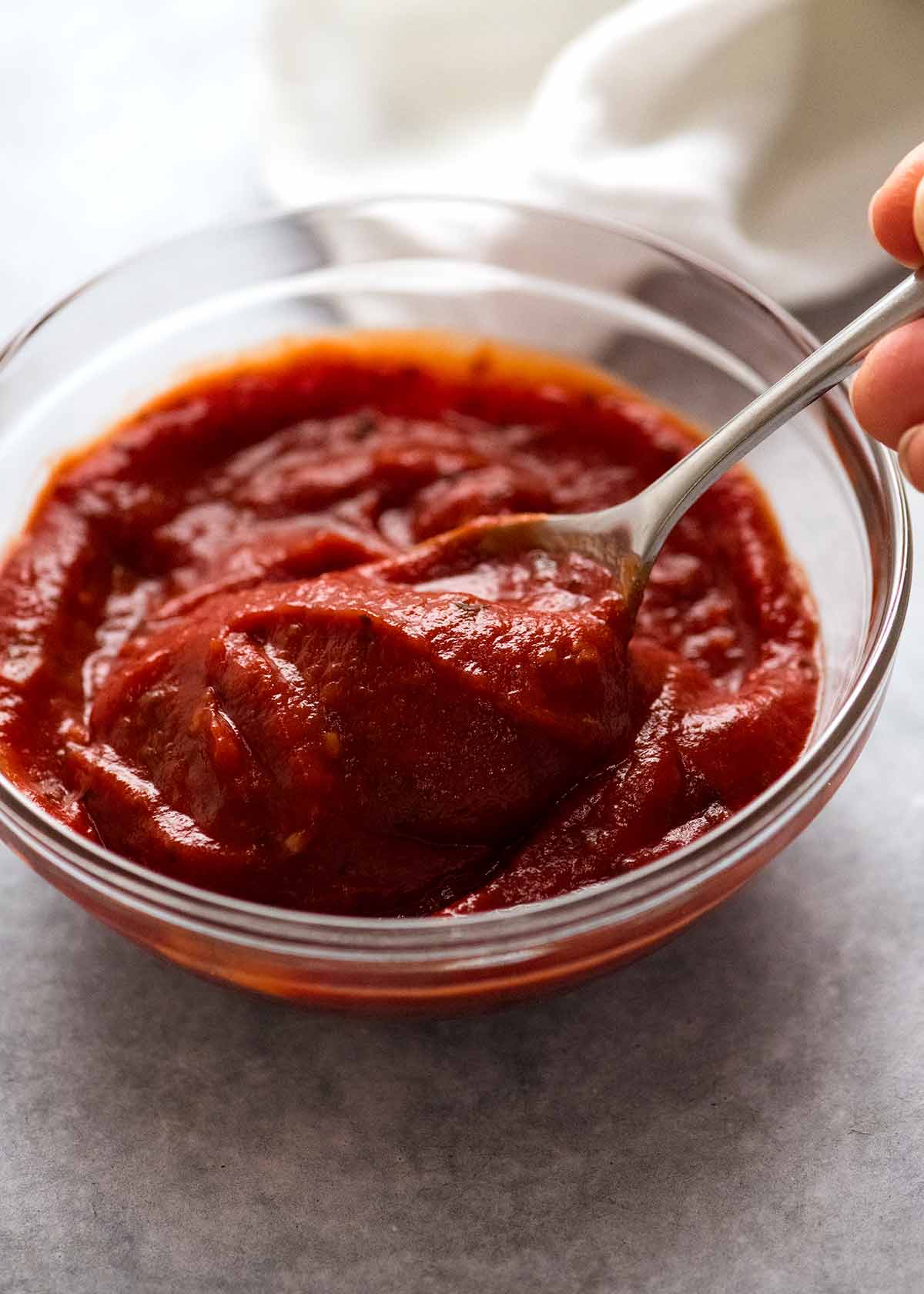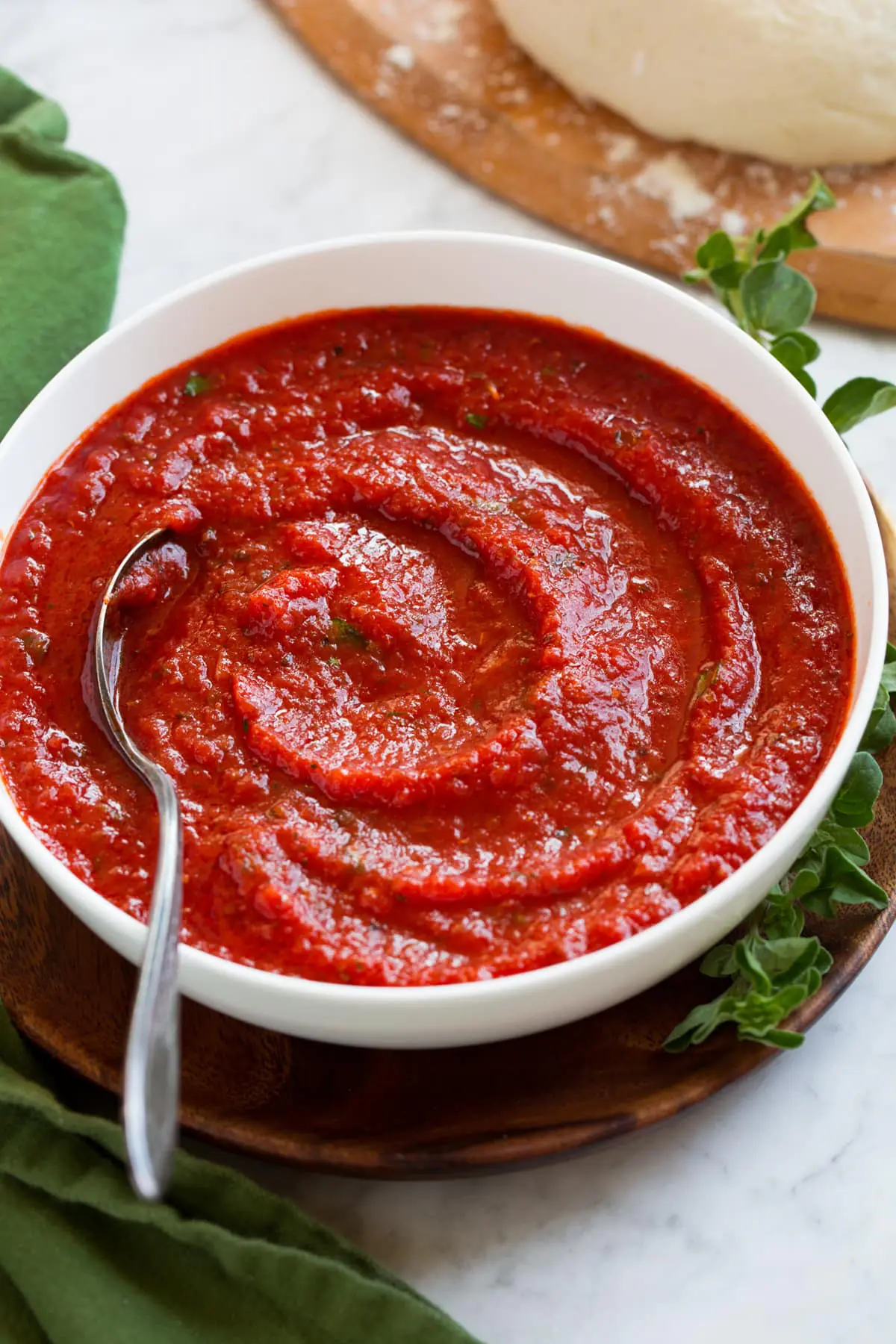To make pizza sauce from tomato paste, mix tomato paste with water, garlic powder, dried basil, dried oregano, salt, and pepper. The result is a delicious and easy-to-make sauce that will elevate your homemade pizzas.
Pizza is a beloved dish enjoyed by people around the world. While many opt for store-bought pizza sauce, making your own can add a personal touch to your homemade pizza creations. Not to mention, it’s surprisingly simple and requires just a few common ingredients.
We will guide you through making pizza sauce from tomato paste. No matter your level of experience in the kitchen, this recipe will enable you to whip up a flavorful sauce that will take your pizza game to new heights. So, let’s dive in and discover how to make pizza sauce from tomato paste!
The Importance Of A Good Pizza Sauce
Pizza is a universally loved comfort food that brings people together. While the crust, cheese, and toppings contribute to its overall deliciousness, the pizza sauce takes it to another level. The sauce acts as the foundation for the flavors, binding all the ingredients together in a harmonious symphony of taste. It is what gives pizza its distinctive character and makes each bite a genuinely memorable experience.
The Role Of Pizza Sauce In Enhancing The Flavors
The pizza sauce is not merely a backdrop; it enhances flavors. To boost the flavor, it plays a vital role. It acts as a conduit, infusing the different elements of the pizza with its rich, savory taste. The combination of tomatoes, herbs, and spices in the sauce adds depth and complexity to the overall flavor profile of the pizza. It creates an irresistible umami sensation that tantalizes the taste buds and keeps you returning for more.
The Impact Of Sauce Consistency On The Overall Quality
The consistency of pizza sauce can significantly impact the overall quality of the pizza. Whether you prefer a thick, chunky sauce or a smooth, silky one, the texture can affect how the sauce coats the crust and interacts with the toppings. A well-balanced sauce, neither too thin nor too thick, strikes the perfect balance, harmonizing the flavors harmoniously. It ensures that every bite of pizza is an explosion of flavors, with the sauce complementing the other ingredients without overpowering them.
Understanding The Key Components Of A Perfect Pizza Sauce
Creating a perfect pizza sauce involves a combination of critical components that elevate the taste. Let’s take a closer look at these elements:
1. Tomatoes:
Choosing the right tomatoes is crucial for a tasty sauce. Opt for canned tomatoes as they are packed at the peak of freshness, ensuring vibrant flavors. Sweet and tangy San Marzano tomatoes, known for their spicy taste, are famous among pizza enthusiasts.
2. Herbs and spices:
The right blend of herbs and spices enhances the complexity of the sauce. Common ingredients include oregano, basil, garlic, onion powder, salt, and pepper. Fresh or dried herbs can be used, based on personal preference, to add flavor to the sauce.
3. Cooking method:
The cooking method used to prepare the sauce can impact its taste. Simmering the sauce longer allows the flavors to develop and intensify. The slow cooking helps the ingredients meld together, producing a robust and well-rounded sauce.
4. Balance:
The key to a perfect pizza sauce is achieving the right flavors. It should be neither acidic nor sweet, striking the ideal equilibrium. Adjust the seasonings and acidity level to create a sauce that complements and enhances the other components of the pizza.
Understanding the importance of a good pizza sauce and its impact on the overall flavor can elevate your pizza-making skills to a whole new level. So don’t settle for anything less than perfection; take the time to make a delicious pizza sauce that will leave your taste buds craving for more.
Choosing The Right Tomato Paste
Evaluating The Different Varieties Of Tomato Paste Available
When it comes to making pizza sauce from tomato paste, selecting a suitable variety of tomato paste is crucial. Not all tomato pastes are created equal, and each has characteristics that affect your sauce’s taste and consistency. Here are a few factors to consider when evaluating the different kinds of tomato paste available:
1. Consistency: Tomato paste comes in different consistencies, such as thick and concentrated or thinner and more diluted. The feeling you choose will depend on personal preference and the desired thickness of your pizza sauce. The more viscous tomato paste will produce a richer and more intense flavor.
2. Flavor: Tomato paste can vary in flavor depending on the type of tomatoes used and the manufacturing process. Some tomato pastes may have a sweeter taste, while others may have a more acidic or tangy flavor. Selecting a tomato paste with a flavor profile that complements your preferred pizza sauce taste is essential.
3. Quality: Opting for high-quality tomato paste ensures a better final result. Look for tomato pastes made from ripe tomatoes that have been processed and packed at the peak of freshness. Make sure no artificial additives or preservatives are included, as these may alter the taste and quality of the pizza sauce.
Factors To Consider When Selecting Tomato Paste For Pizza Sauce
Choosing the suitable tomato paste for your pizza sauce involves considering various factors that can influence the sauce’s taste, texture, and overall quality. Here are some essential elements to keep in mind:
1. Concentration: Tomato paste is typically sold in small cans or tubes, ranging from 6 to 8 ounces. Check the concentration of the paste, as some brands offer double-concentrated options that can provide a more intense tomato flavor with less quantity. Adjusting the amount based on the attention will help you achieve the desired taste for your pizza sauce.
2. Ingredients: Look closely at the ingredient list on the tomato paste packaging. Ideally, the list should be short and free from unnecessary additives and fillers. Look for tomato paste that contains only tomatoes and possibly a tiny amount of salt. Avoid products with added sugars, artificial flavors, and preservatives.
3. Texture: Pay attention to the texture of the tomato paste. It should be smooth and free from lumps or seeds. A velvety texture allows easy incorporation into your pizza sauce, ensuring a homogeneous and consistent result.
Tips For Finding High-quality Tomato Paste In The Market
Finding high-quality tomato paste amidst the myriad of choices in the market can be a daunting task. However, by following a few tips, you can ensure you get the best tomato paste for your pizza sauce:
1. Choose reputable brands: Trusted and well-established brands often pride themselves on producing high-quality products. Look for brands with a reputation for using ripe tomatoes and careful processing techniques.
2. Read customer reviews: Before purchasing a particular tomato paste brand, spend a few minutes reading customer reviews. Pay attention to feedback about flavor, consistency, and overall satisfaction. This can give you valuable insights into the quality of the product.
3. Consider organic options: If you prefer to avoid pesticides and chemicals in your food, consider opting for organic tomato paste. Organic varieties are made from tomatoes grown using organic farming practices, ensuring a more natural and potentially healthier option for your pizza sauce.
4. Check for quality certifications: : Look for tomato paste with quality certifications, such as USDA organic certification or non-GMO verified labels. The certificates indicate the product has been rigorously tested and meets specific quality standards.
You can select the suitable tomato paste for your pizza sauce by examining the available options and considering crucial factors like consistency, flavor, and quality. Choosing high-quality tomato paste sets the foundation for a delicious and flavorful homemade pizza.
Enhancing Flavor With Herbs And Spices
Enhancing the flavor with herbs and spices is the key to creating a truly delicious and memorable sauce when making pizza sauce from tomato paste. By carefully selecting the right combination of seasonings, you can elevate the taste of your pizza sauce to a whole new level. This article will explore the best herbs and spices to add to tomato paste, understand the proportions and combinations for a balanced flavor profile, and discover tips and tricks for incorporating herbs and spices into the sauce.
Exploring The Best Herbs And Spices To Add To Tomato Paste
When selecting herbs and spices for your pizza sauce, numerous options exist. Here are some popular herbs and spices that can bring out the best flavors in your tomato paste:
| Herb/Spice | Flavor Profile | Suggested Proportion |
| Basil | Earthy and slightly sweet | 1 teaspoon per cup of tomato paste |
| Oregano | Robust and slightly bitter | 1 teaspoon per cup of tomato paste |
| Garlic | Strong and pungent | 1-2 cloves per cup of tomato paste |
| Onion | Sharp and savory | 1 tablespoon per cup of tomato paste |
| Red pepper flakes | Spicy and hot | To taste |
Understanding The Proportions And Combinations For A Balanced Flavor Profile
To achieve a balanced flavor profile in your pizza sauce, it is essential to understand the proportions and combinations of herbs and spices. Here are some general guidelines to keep in mind:
- Start with a small amount of each herb and spice, adding more to taste.
- Balance the flavors by combining earthy herbs like basil and oregano with more pungent spices like garlic and onion.
- Consider the intensity of each herb or spice and adjust the proportions accordingly.
Tips And Tricks For Incorporating Herbs And Spices Into The Sauce
Here are some valuable tips and tricks to ensure that your pizza sauce incorporates herbs and spices effectively:
- Simmer the tomato paste with the herbs and spices to allow the flavors to meld together.
- If using dried herbs and spices, crush or grind them before adding to the sauce to enhance their flavor.
- Experiment with different combinations and proportions to find your favorite flavor profile.
- Consider using fresh herbs for a brighter and more vibrant taste.
Achieving The Perfect Consistency
Techniques For Adjusting The Thickness Of The Sauce
Acquiring the ideal consistency is critical when creating the perfect pizza sauce from tomato paste. The sauce’s thickness can significantly affect your pizza’s overall taste and texture, so it’s essential to know how to adjust it to your liking. Here are some techniques to help you achieve just the right thickness:
- Adding water: If your sauce is too thick, a simple way to thin it out is by adding water. Start by adding a small amount at a time, stirring well in between, until you reach the desired consistency. This method gives you complete control over how thin or thick your sauce is.
- Cooking longer: Alternatively, cook more sauce to reduce the liquid content and thicken it up. Simmering the sauce gently over low heat will help evaporate excess moisture, resulting in a thicker consistency.
- Using a thickening agent: Another option is to add thickening agents, such as cornstarch or flour, to achieve the desired thickness. To do this, mix the thickening agent with cold water to make a slurry, then gradually add it to the sauce while stirring. Allow the sauce to simmer for a few minutes to allow the thickening agent to do its magic.
Using Additional Ingredients To Achieve Desired Consistency
If you’re looking to add more flavor and texture to your pizza sauce while adjusting its consistency, consider incorporating these additional ingredients:
- Tomato puree: Adding tomato puree alongside the tomato paste can help enhance the thickness of the sauce without compromising the flavor. This will give your sauce a richer and more robust taste.
- For a smoother and silkier consistency, drizzle some olive oil into the sauce. This not only helps in achieving a desirable thickness but also adds a delightful aroma to your sauce.
- Garlic and herbs: To infuse your sauce with aromatic flavors and give it a thicker texture, mix in minced garlic and herbs like basil, oregano, or thyme. These ingredients will contribute to the overall thickness and enhance the taste profile of your pizza sauce.
Balancing The Sauce’s Thickness For Different Types Of Pizza
Each type of pizza may require a slightly different sauce thickness to complement its specific characteristics. Here’s a rough guideline on how to balance the sauce’s thickness for different types of pizza:
| Type of Pizza | Ideal Sauce Thickness |
|---|---|
| New York-style thin crust | Medium-thin consistency to prevent soggy crust |
| Neapolitan-style | Thin and slightly watery consistency, as the pizza cooks quickly at high temperatures |
| Chicago-style deep dish | Thicker consistency to support the thick crust and layers of toppings |
| Gluten-free | Medium consistency to prevent the pizza from becoming too dry |
By considering the type of pizza you are making, you can adjust the sauce’s thickness accordingly to achieve the perfect balance between flavor, texture, and structure
Cooking And Storing Tips
Cooking and storing homemade pizza sauce is a great way to add freshness to your pizza and allows you to customize the flavors according to your preference. With a few simple cooking and storing tips, you can ensure that your pizza sauce turns out delicious and stays fresh for future use.
Proper Cooking Methods For The Pizza Sauce
When it comes to cooking pizza sauce from tomato paste, a few methods can help you achieve the best flavor and consistency. Here are some proper cooking methods to consider:
- Simmering: Simmering the sauce on low heat melds the flavors, resulting in a rich and flavorful sauce. This method also helps to thicken the sauce as it cooks. Remember to keep stirring occasionally to prevent it from sticking to the bottom of the pan.
- Adding herbs and spices: To enhance the taste of your pizza sauce, consider adding herbs and spices like oregano, basil, garlic powder, or red pepper flakes. This will give your sauce an extra kick and add depth to the overall flavor.
- Blending: Blend or process the sauce if you prefer a smoother consistency. This will give you a silky texture that spreads quickly onto the pizza dough, ensuring each bite is as enjoyable as the next.
Tips For Storing And Preserving The Sauce
Proper storage is essential to keep your homemade pizza sauce fresh and delicious for future use. Follow these tips to ensure your sauce stays at its best:
- Use airtight containers: Transfer the cooled sauce into airtight containers or glass jars to keep it fresh. Make sure to leave some headspace to allow for expansion when freezing.
- Label containers: It’s important to label each container with the date of preparation so that you can keep track of its freshness and use it accordingly.
- Refrigerate or freeze: If you plan to use the sauce within a week, store it in the refrigerator. For more extended storage, freezing is the best option. Keeping frozen pizza sauce for up to three months is possible without compromising its quality.
- Easily portable: Consider dividing the sauce into smaller portions before freezing. This way, you can quickly defrost and use only the amount you need without thawing the entire batch.
Recommended Shelf Life And Storage Options For Leftover Sauce
Leftover pizza sauce can come in handy for various dishes. Here’s what you need to know about its recommended shelf life and storage options:
Storage Option Shelf Life Refrigerator Up to 1 week Freezer Up to 3 months
Always defrost your frozen pizza sauce in the refrigerator overnight before using it. As a result, the flavors will remain intact, and the sauce will retain its original taste.
By following these cooking and storing tips, you can enjoy homemade pizza sauce anytime, knowing that you have a flavorful and convenient sauce readily available to create your perfect pizza masterpiece.

Credit: www.recipetineats.com
Frequently Asked Questions Of How To Make Pizza Sauce From Tomato Paste
You’ll need tomato paste, olive oil, garlic, dried oregano, dried basil, sugar, salt, and pepper to make pizza sauce from tomato paste.
To make pizza sauce from tomato paste, mix the tomato paste with olive oil, minced garlic, dried oregano, dried basil, sugar, salt, and pepper. Stir until all ingredients are well combined.
Yes, you can use tomato sauce instead of paste for pizza sauce. Just make sure to adjust the quantities of the other ingredients to balance the consistency and flavor of the sauce.
Conclusion
Making pizza sauce from tomato paste is a simple and delicious way to enhance your homemade pizza. With the steps outlined in this blog post, you can create a flavorful sauce with just a few ingredients.
It doesn’t matter whether you prefer a traditional tomato-based sauce or want to add your unique twist; making pizza sauce from tomato paste is a great option. So why wait? Grab a can of tomato paste and start experimenting today!

As the author of the “Ultimate Pizza Guide: Recipes, Tips & Secrets Revealed,” I’m dedicated to sharing my love for pizza and empowering others to create delicious homemade pizzas with ease. Join me on a journey to uncover the secrets to perfecting your pizza game!



